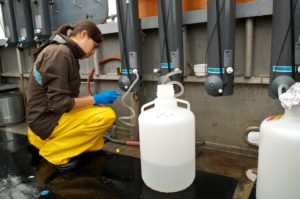UBC team develops predictive marine microbiome math model.

Collecting sampled waters from Saanich inlet into carboys for large volume filtration of microbial biomass. (Image courtesy of Steven Hallam, UBC)
The Science
With help from two DOE national user facilities, a team at the University of British Columbia (UBC) has developed a math model that could help researchers and policy makers track the impact of climate change on the microbial networks that drive the world’s marine ecosystems. The model couples omic information and biogeochemical data from the Saanich Inlet ecosystem in British Columbia, Canada, which has long been used as an analog for studying oxygen minimum zones.
The Impact
Traditional earth systems models that help researchers predict the effects of a changing climate have not historically incorporated information about the microbial communities that play key roles in maintaining the planet’s biogeochemical cycles. Having a model that incorporates multi-omic and biogeochemistry data allows researchers to make more accurate projections.
Summary
Climate change and waste runoff have led to an increase in ocean oxygen minimum zones (OMZs), areas in the ocean where the level of dissolved oxygen is lower than required for multicellular life to thrive. There are currently more than 500 OMZs worldwide and the metabolism of the microbial communities in these oxygen-starved waters affects both nutrient and energy conversion processes, including the production and consumption of the greenhouse gases carbon dioxide, methane, and nitrous oxide.
“It takes a network to study networks. A drop of seawater can contain millions of single-celled microbes that collectively form the basis for nutrient and energy cycles in the ocean,” said DOE Joint Genome Institute (DOE JGI) collaborator and UBC microbial ecologist Steven Hallam. “Understanding how microbial processes contribute to these cycles is vital in a time of climate change. Our model provides a step change in more accurate projections of microbial processes with potential feedback on climate change and ecosystem health.” The omics component of the model comes from Hallam’s work with the DOE JGI through the latter’s Community Science Program.
This work was accomplished in partnership with two user facilities stewarded by the Office of Biological and Environmental Research within DOE’s Office of Science: the DOE JGI at Lawrence Berkeley National Laboratory (Berkeley Lab), and the Environmental Molecular Science Laboratory (EMSL) at Pacific Northwest National Laboratory. The study appeared online September 21, 2016 in the Proceedings of the National Academy of Sciences.
“The convergence of high-throughput data generation, computation and simulation emerging from Saanich Inlet provides an extensible framework for examining the dynamic interplay between microbiomes, ecosystems and formulating human responses to climate change,” said UBC geomicrobiologist Sean Crowe, one of the authors of the study.
Contacts
Daniel Drell, Ph.D.
Program Manager
Biological Systems Sciences Division
Office of Biological and Environmental Research
Office of Science, US Department of Energy
daniel.drell@science.doe.gov
Steve Hallam
ECOSCOPE Director
CIFAR Scholar and Associate Professor
University of British Columbia
shallam@mail.ubc.ca
Funding
- DOE Office of Science
- G. Unger Vetlesen and Ambrose Monell Foundations
- Tula Foundation
- Natural Sciences and Engineering Research Council of Canada (NSERC)
- Genome British Columbia
- Canada Foundation for Innovation
- Canadian Institute for Advanced Research
Publications
- Louca S et al. Integrating biogeochemistry with multiomic sequence information in a model oxygen minimum zone. Proc Natl Acad Sci. 2016 September 21. doi:10.1073/pnas.1602897113
Related Links
- http://jgi.doe.gov/decoding-virus-host-interactions-in-oxygen-starved-ocean/
- Video Link: http://bit.ly/JGIUM2010Hallam
- http://jgi.doe.gov/news_09_10_22/
- http://jgi.doe.gov/why-sequence-a-near-shore-anoxic-basin/
- http://jgi.doe.gov/steven-hallam-university-british-columbia/
- The University of British Columbia news release: https://science.ubc.ca/news/new-model-could-point-way-microbiome-forecasting-ocean